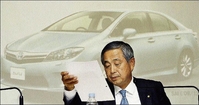
Toyota Motor Corp Executive Vice President Yoichiro Ichimaru checks a document as he speaks during a press conference in Tokyo, Japan, last Thursday. Toyota said Thursday it returned to a profit in the latest quarter as government incentives boosted sales, leading the world's largest automaker to trim its projected red ink for the year. - Contributed
TOKYO (AP):
Toyota Motor Corp reported a surprise profit Thursday and cut its projected red ink for the year by half, adding to growing evidence that carmakers are starting to recover from the deepest industry downturn in years.
Although far from a full-fledged turnaround, Toyota's results showed the healing effects of government stimulus measures to spur sales of environmentally friendly cars and other vehicles, as well as soaring demand in emerging markets like China. Rivals Honda Motor Co. and Nissan Motor Co. have also issued healthier reports and outlooks recently.
For the July-September quarter, Toyota, the world's largest car company, posted better-than-expected net income of 21.8 billion yen (US$242 million) after three straight losing quarters, defying some expectations of another loss.
clearest signs yet
That marked an 84 per cent tumble from the 139.8 billion yen the company earned in the same quarter a year ago, but was still one of the clearest signs yet Toyota was rebounding from its biggest loss ever during the last fiscal year.
Especially positive were gains in China, where Toyota vehicle sales last quarter surged to a record at more than 204,000 vehicles, up 39 per cent from the same period the previous year. China's auto market is on track to become the world's biggest, replacing the US, this year.
With sales proving better than expected the last six months, Toyota upped its sales forecasts for the fiscal year through March 2010, from 7.03 million vehicles from 6.6 million. It also expected a smaller loss for the fiscal year of 200 billion yen (US$2.2 billion) - less than half the 450 billion yen (US$5 billion) loss it predicted earlier.
revised forecast
The revised vehicle forecast was still a seven per cent drop from the more than 7.5 million vehicles Toyota, which makes the Prius hybrid and the Corolla subcompact, sold around the world in the last fiscal year. Still, sales were growing in Asia compared to a year ago.
Executive Vice-President Yoichiro Ichimaru said Toyota made good progress on "emergency" efforts to combat its crisis by cutting costs, while acknowledging that global uncertainties remained.
"We continued to make improvements in our reductions in fixed costs," he said. "In addition, demand-stimulating measures by governments worldwide have contributed to our revised targets."